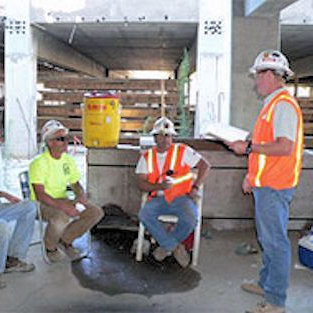16.T.08 Operational Criteria.
- Hoisting of the personnel platform must be in a slow, controlled, cautious manner with no sudden movements.
- Load lines must be capable of supporting, without failure, at least 7 times the maximum intended load, except where rotation resistant rope is used the lines must be capable of supporting, without failure, at least 10 times the maximum intended load. The required design factor is achieved by taking the current safety factor of 3.5 and applying the 50% de-rating of the crane capacity.
- A Qualified Person must determine if the footing is sufficiently firm and stable for the operation. The crane must be uniformly level within 1 degree of level grade and located on firm footing. LHE equipped with outriggers must have them all equally deployed to load chart criteria following manufacturer's specifications, as applicable, when hoisting personnel.
- The total weight of the loaded personnel platform and related rigging must not exceed 50% of the rated capacity for the radius and configuration of the crane.
- Only LHE with an A2B device that prevents contact between the load block or overhaul ball and the boom tip, or a system that deactivates the hoisting action before damage occurs must be used.
- LHE with variable angle booms must be equipped with a boom angle indicator readily visible to the operator.
- LHE with telescoping booms must be equipped with a device to indicate clearly to the operator, at all times, the boom's extended length, or an accurate determination of the load radius to be used during the lift must be made prior to hoisting personnel.
- The load line hoist drum must have a system or device on the power train, other than the load hoist brake, that regulates the lowering rate of speed of the hoist mechanism (controlled lowering). Free-fall is prohibited.
16.T.09 Trial Meeting, Trial Lift and Inspection.

Be sure to have a pre-lift meeting prior to all trial lifts.
- Prior to every trial lift, the LHE operator, signal person, employees to be lifted, and the CP must attend a pre-lift meeting to review the applicable parts of this manual, the AHA, and the details of this particular lift.
- A trial lift with the unoccupied work platform loaded at least to the anticipated lift weight must be made from the ground level, or any other location where employees will enter the platform, to each location at which the work platform is to be hoisted and positioned.
- The trial lift must be made immediately prior to each shift in which personnel will be hoisted and must be repeated prior to hoisting employees after the LHE is moved and set up at new location or returned to a previously used location, and when the lift route is changed unless the CP determines that the route change is not significant.
- The operator must determine that all systems, controls, and safety devices are activated and functioning properly; that no interferences exist; and that all configurations necessary to reach those work locations will allow the operator to remain under the 50% limit of the equipment's rated capacity.
- Materials and tools to be used during the actual lift may be loaded in the platform (evenly distributed and secured) for the trial lift.
- After the trial lift and just prior to hoisting employees, the platform must be hoisted a few inches and inspected to ensure that it is secure and properly balanced.
- A visual inspection of the LHE, rigging, work platform, and the crane support base must be conducted by a CP immediately after the trial lift to determine whether the testing has exposed any defect or produced any adverse effect upon any component or structure.
- Any defects found during inspection which create a safety hazard must be corrected before hoisting personnel.
- If the load rope goes slack, the hoisting system must be re-inspected to ensure that all ropes are properly seated on drums and sheaves.
16.T.10 Proof Testing
- At each job site, prior to hoisting employees on the work platform, and after any report or modification, the platform and rigging must be proof tested to 125% of the platform's rated capacity by holding it in a suspended position for 5 minutes with the proof test load evenly distributed on the platform (this may be done concurrently with the trial lift).
- After proof testing, a CP must inspect the platform and rigging. Personnel hoisting must not be conducted until the CP determines that the platform and rigging have successfully passed the proof test.
Knowledge Check Choose the best answer for the question.
16-26. The total weight of the loaded personnel platform and related rigging _____ for the radius and configuration of the crane.
You forgot to answer the question!

